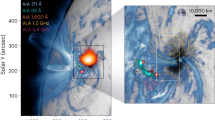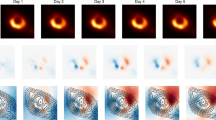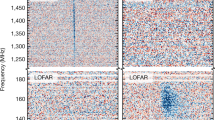Abstract
The stimulation by Io of some fraction of the jovian decametre-wavelength radio emission was recognized in 19641. Since then many observations have indicated that strong Io control is limited to frequencies between about 22 and 40 MHz (refs 2–4). At lower frequencies, that is 8–10 MHz, the degree of Io modulation declines markedly5. Recent low-frequency RAE 1 satellite6, Voyager 1 (ref. 7), and groundbased8 studies have shed some doubt on the conclusion that Io control predominates only at high frequencies. Data from the Earth-orbiting RAE 1 satellite6 revealed a strong dependence of emission detection probability on Io orbital phase at frequencies in the range 6.5–2.2 MHz. These apparently conflicting results lead to two different conclusions: (1) Io control decreases markedly in the 10–20 MHz regime but reappears near 6 MHz, or, (2) observations above 8 MHz require5 that the emission intensity be taken into account. We demonstrate here that the latter is the case and offer a reinterpretation of these data which is consistent with the recent low-frequency satellite and groundbased results.
This is a preview of subscription content, access via your institution
Access options
Subscribe to this journal
Receive 51 print issues and online access
$199.00 per year
only $3.90 per issue
Buy this article
- Purchase on Springer Link
- Instant access to full article PDF
Prices may be subject to local taxes which are calculated during checkout
Similar content being viewed by others
References
Bigg, E. K. Nature 203, 1008 (1964).
McCulloch, P. M. & Ellis, G. R. A. Planet. Space Sci. 14, 347 (1966).
Wilson, R. G., Warwick, J. W. & Libby, W. F. Nature 220, 1215 (1968).
Register, H. I. thesis, Univ. Florida (1968).
Dulk, G. A. & Clark, T. A. Astrophys. J. 145, 945 (1966).
Desch, M. D. & Carr, T. D. Astr. J. 83, 828 (1978).
Warwick, J. W. et al. Science 204, 995 (1979).
Witham, P. S. Nature 272, 40 (1978).
Desch, M. D., Carr, T. D. & Levy, J. Icarus 25, 12 (1975).
Desch, M. D. & Carr, T. D. Astrophys. J. Lett. 194, L57 (1974).
Goldreich, P. & Lynden-Bell, D. Astrophys. J. 156, 59 (1969).
Wu, C. S. & Freund, H. P. Astrophys. J. 213, 575 (1977).
Gurnett, D. A. Astrophys. J. 175, 525 (1972).
Goertz, C. K. Planet. Space Sci. 21, 1431 (1973).
Acuna, M. H. & Ness, N. F. in Jupiter (ed. Gehrels, T.) 830 (University of Arizona Press, 1976).
Author information
Authors and Affiliations
Rights and permissions
About this article
Cite this article
Desch, M. Io control of jovian radio emission. Nature 287, 815–817 (1980). https://doi.org/10.1038/287815a0
Received:
Accepted:
Issue Date:
DOI: https://doi.org/10.1038/287815a0
Comments
By submitting a comment you agree to abide by our Terms and Community Guidelines. If you find something abusive or that does not comply with our terms or guidelines please flag it as inappropriate.



